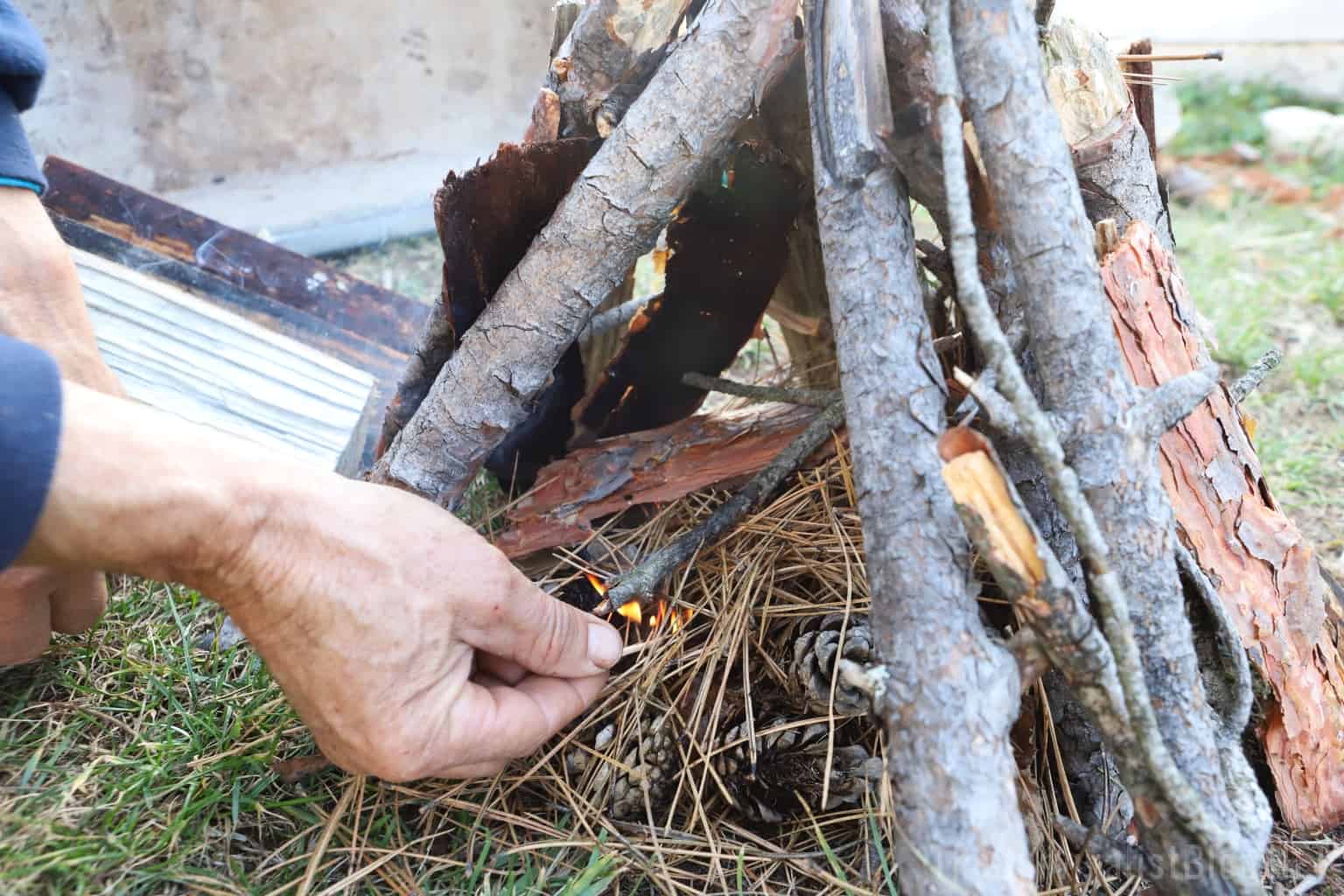Pine trees are some of the most common trees you’ll find in North America. It is a natural resource that has a myriad of uses and has been used in the construction of city infrastructure and tiny homes alike.

It is a fast-growing tree that can be planted into tight-fitting plantations for easy harvest. Animals use pine trees for nests and homes at various times of the year.
Pine is used extensively for outdoor projects because of the waterproof and sealing qualities of the resin within.
As you can probably figure out, pine trees are a vital part of everyday life for many people and animals.
One of the common uses for old pine is burning it in a campfire or a wood stove. With many types of wood to choose from, does pine burn well as firewood?
No, pine does not make for effective firewood if you want prolonged heat. Pine burns at a low temperature that wouldn’t be effective at heating a house, so you’ll notice extensive creosote buildup in your chimney. It also burns pretty quickly.
This doesn’t mean you should count pine out of the fire game. Pine trees are an incredible resource for starting fires and other applications.
If you have lots of pine near you, count your blessings as these trees can bring a lot of value.
What’s The Heat And Smoke Output Of Pine?
As mentioned previously, firewood from pine trees is not the best material for a fire. The only way to measure it is by using the BTU (British Thermal Unit) per cord method.
Pine firewood rates at 17 million BTUs per cord which is at the lower end of the scale for heat strength and energy output. In comparison, black locust burns at about 28 million BTUs per cord.
Where pine starts to shine is in its ability to get a fire going strong right away. This is because the resin that is inside the wood is extremely flammable.
It burns out quickly, but you can use pine to get your hardwood pieces started.
If you’re outside using pine in a campfire then you have nothing to worry about, if you’re burning it in a wood stove then watch out for creosote buildup.
Pine firewood produces a lot of black smoke when it is on fire. This is due to the flammable resin inside that doesn’t burn completely which gives off this black, acrid smoke that you don’t want to inhale.
The only way around this is to season your firewood properly, you’ll find that dry firewood will burn cleaner as opposed to wet firewood where steam and smoke will rise until it dries itself out.

Does Pine Firewood Make A Good Coal Bed?
Coal beds are the byproduct of your firewood burning down into charcoal. These coals are responsible for keeping your fire going as you toss more firewood to your fire.
The quality and type of wood that you use have an impact on the strength and length that your coals will be able to contain their heat.
Pine does not produce any coals of significance as the resin burns away completely, incinerating the wood around it.
This makes it a poor choice for using overnight in a stove or outside as you find that you’ll be stoking the fire and adding wood every hour or so.
Regardless of how late into the night you burn your fire, you will often find no embers or coals in the morning as the fire is complete and swift.
If you’re camping in the summertime you might have some luck as the ambient temperatures are warmer than the winter, for example.
Keep this in mind if you want to use pine as a firewood source during cold winter nights.
Common Pine Tree Varieties
Eastern White Pine (Pinus strobus)
The most common type of pine tree in the world. It has clusters of five-needle fascicles that erupt from the branches, these needles are soft and almost like bristles on a paintbrush.
This wood is great for getting an outdoor fire as it is packed full of flammable resin.
Pine needles that have turned brown from being dried out make for a good fire accelerant to throw on. This pine is also used a lot in construction.
Red Pine (Pinus Resinosa)
You’ll see these trees used in making telephone poles that you see at the side of the road.
Red pines go very tall and straight, which makes them ideal for poles and timber. This pine tree has a more intense resin within it that has a strong turpentine smell.
If you see a downed red pine, cut off a branch or cut into the stump to find resin-impregnated wood that is both flammable and waterproof.
Jack Pine (Pinus banksiana)
The jack pine is one of those trees that doesn’t grow straight (much like the pitch pine). This tree lives in rocky soil and can stand for a long time.
This is one of the pines that require a forest fire to burn the tree and open the cones, effectively spreading seeds.
With two needles per fascicle, you can easily confuse this with the red pine if it weren’t for the old, weathered bark, with cracks running through it.
Generally, this tree has gray or brown bark, as opposed to the noticeable red that the red pine showcases. This is an average burning pine that can provide short bursts of heat.
Ponderosa Pine (Pinus Ponderosa)
This pine tree is the most widely distributed and can be recognized worldwide. This tree is easily recognized by its red platelike bark that interlocks with itself.
It can be an invasive species as New Zealand seems to have had an abundance growing since its introduction, choking out any of the native wildlife.
Since it is heat resistant, it does take a little while for it to get burning, but that means it also burns a little longer than other pine trees.
Creosote Is A Danger Of Burning Pine Wood
Creosote is the build-up of black carbon that appears in your chimney as a result of incomplete burning from low-temperature fires.
Accumulating creosote is unavoidable when burning any type of wood, but you can control how much you accumulate during a burn session by choosing the right wood for the job.
Wood with a lot of sap or resin will create lots of creosote as not all of the particles will burn up and get transferred with the smoke up the chimney.
If you are burning exclusively softwood in a wood store or fireplace then expect to clean your chimney out monthly, depending on how much you use it.
Don’t let it build up or it can cause a blockage that will get hot and start a chimney fire.
Make sure that your pine firewood is dry and that will also mitigate smoke production and avoid creosote buildup.
If your wood is wet it tends to produce more smoke as the fire attempts to evaporate any excess moisture.
Punky wood tends to also burn poorly and will either smother the fire or cause it to smolder instead of burn.

Perrin is a nomad surviving and thriving in in the Canadian forests. His areas of expertise include wilderness survival, primitive living, tracking wildlife, and teaching others about this way of life. He has has a “first-responder” certification and is a “leave no trace” expert.


Pine may not be the best firewood, but it works OK to make charcoal if you use a closed retort. As charcoal, the impurities you discuss are driven off or pyrolized.
The burls and pitch build up in the southern yellow pine, burn very hot like burning plastic. It burns fast, so does the white and red oak that has been seasoned properly. I have found with my wood burning box to start the fire fast and let it burn hot to get the chill off and then maintain.
The Creosote can be knocked out of the stove pipe with yearly cleaning, unlike a chimney which needs a sweep. We nearly burnt a cord of wood in the Great Texas Freeze.